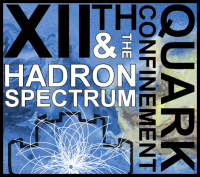Speaker
Description
A massive expansion, based on massive free-particle propagators,
can be set up from first principles[1-3] and shown to be
a powerful variational tool disguised to look like a perturbative approximation[3].
By its optimization, the method provides an analytical tool for exploring the
propagators of QCD deep in the infrared of Minkowski space[3] and from first principles,
without having to alter the Landau gauge Faddeev-Popov Lagrangian in any way.
The expansion is safe in the infrared and is equivalent to the standard perturbation theory in the UV[2,3].
At one-loop, all diverging mass terms cancel exactly without spurious mass counterterms that
would spoil gauge and chiral symmetry of the Lagrangian.
Gluon mass generation and dynamical breaking of chiral symmetry are described in the
same framework.
The propagators emerge as analytic functions and can be easily studied in Minkowski space, shading some
light on analytic properties that could be hardly explored by numerical methods.
Among the main findings, universal scaling properties are predicted for the inverse dressing functions and
shown to be satisfied by the lattice data that collapse on a universal function, irrespective of couplings,
number of colors and of quarks. Direct evidence is given for positivity violation and confinement of gluons and
quarks. Complex conjugated poles are found for the gluon propagator, in agreement with the i-particle scenario[4]. The relatively small contribution of the
continuos gluon spectral function explains the phenomenological success of simple tree-level
rational propagators that arise in the refined Gribov-Zwanziger[5] and replica models[6].
[1] F. Siringo, Perturbative study of Yang-Mills theory in the infrared, arXiv:1509.05891.
[2] F. Siringo, Analytical study of Yang-Mills theory in the infrared from first principles, Nucl.Phys.B907, 572 (2016); arXiv:1511.01015.
[3] F. Siringo, Analytic structure of QCD propagators in Minkowski space,
arXiv:1605.07357
[4] L. Baulieu, D. Dudal, M. S. Guimaraes, M. Q. Huber, S. P. Sorella, N. Vandersickel, D. Zwanziger, Phys.Rev.D82, 025021 (2010).
[5] D.Dudal, S.P.Sorella, N.Vandersickel, H.Verschelde, Phys.Rev.D77, 071501 (2008).
[6] S. P. Sorella, J.Phys.A44, 135403 (2011).
Summary
Analytical functions for the propagators of QCD, including a set of chiral quarks, are derived by a one-loop massive expansion in the Landau gauge, and are studied in Minkowski space, yielding a direct proof of positivity violation and confinement from first principles. Complex conjugated poles are found for the gluon propagator.
